Baby Bunting (ASX: BBN) competitors have dropped like flies, paving the way for it to become the leading specialty baby products retailer in Australia and has its sights set on New Zealand. The Baby Bunting share price has risen 130% since listing in October 2015 after a tough first few years when it reached a low of $1.32 cents per share in March 2018. In FY 2022, Baby Bunting recorded $507.3 million of revenue, an increase of 8.3% compared to FY 2021. Baby Bunting also revealed a net profit after tax of $19.5 million, representing a 14.6% lift on the last financial year. Let’s take a walk down memory lane to understand why and how Baby Bunting competitors have struggled.

Baby Bunting Beats Its Competition
Baby Bunting was founded in 1979 by Arnold and Gail Nadelman who opened the first store in Camberwell, Melbourne. The Nadelman Family are no longer substantial shareholders and do not play a role in managing the business. In FY 2012, TDM Asset Management now known as TDM Growth Partners became the largest shareholder with a 42% interest. Around the same time, current CEO Matt Spencer joined from Kathmandu. At this time, Baby Bunting had 19 stores and former international giant Mothercare was the biggest global Baby Bunting competitor.
Mothercare once had around 353 stores in the UK and 969 overseas in 2009 based on this BBC News article. The global baby products retailer tried to penetrate the Australian market in 2010 but this folded by 2013 after a failed attempt to sell the business to Myer (ASX: MYR). And then not long ago in November 2019, the Mothercare group entered into voluntary administration. I think understanding the reasons for Mothercare’s collapse not only provides insights into why Baby Bunting may have been successful, but also identifies red flags to keep an eye on as it grows.
First, let’s take a look at Mothercare’s failed venture in Australia. According to a report by the Sydney Morning Herald, Mothercare Australia advised it had been affected by tough trading conditions in Australia due to weak consumer demand and price wars with its rivals. First of all, Mothercare Australia’s strategy was to acquire existing Australian Baby Bunting competitors along with store rollouts. In the FY11 annual report for Mothercare Australia, management highlighted weak consumer demand and price-based competition as reasons for lower revenue. Further, management noted integration costs associated with the merger of three businesses involved significant costs.
In FY12, Baby Bunting brought in cash receipts of $111.8 million and recorded an operating cash outflow of $1.06 million from around 19 stores. Compare this to Mothercare Australia, which recorded $88.7 million in cash receipts and operating cash outflow of $2.8 million, operating around 49 stores. After Mothercare Australia posted its FY12 results, it locked in a conditional sale to Myer but the UK baby products retailer failed to hit the requisite targets. Mothercare Australia seemed to struggle to compete with incumbents as the challenge to negotiate better margins with suppliers became too much, and it didn’t help that a lot of capital was being sucked up by the integration of acquired stores. This expansion attempt provided some early warning signs of Mothercare’s eventual administration in 2019.
A lot of retail analysts and professional services experts chimed in to provide reasons for Mothercare’s demise. They centred on customer value proposition, adaptation and management. One customer reported to BBC News that she wasn’t surprised by the collapse, “since they were not prepared to adapt to customer needs and purchasing trends“. One thing she highlighted was the constant geoblocking that automatically redirected her to the Irish website rather than the UK website, preventing her from sending links of gift suggestions to her in-laws based in the UK.
Another customer expressed their frustration with Mothercare’s inability to understand his needs after purchasing a pram, constantly receiving discount marking campaigns instead of products that he needed. I think these two anecdotes serve as examples of what can go wrong when a business loses touch with its customers and stops disrupting itself to improve the customer value proposition and leverage technological developments.
Richard Lim, chief executive at Retail Economics noted Mothercare had been beaten “on price, convenience and the overall customer experience’. Whilst this quote provides the overarching view, his further comment about Mothercare failing to differentiate itself from rivals as a specialist baby products retailer was the most poignant.
It is all about creating a meaningful experience. For expectant parents, they don’t know how much things are going to cost and what to buy [but] Mothercare didn’t provide an environment where they were supported. Parents didn’t have a strong enough reason to go and visit Mothercare.
How does Baby Bunting fare across these three areas? Baby Bunting offers a promise to beat any competitor’s price by 5%, so it wins on price. One big differentiator in Baby Bunting’s business is it offers baby car seat installation services when you park in a Baby Bunting allocated parking spot, making it super convenient. If you check out the overall store layout, it’s spacious, with product tags containing clear and big lettered descriptions and they’re covered in plastic in the event babies decide to take them in their own hands with some vomit or saliva.
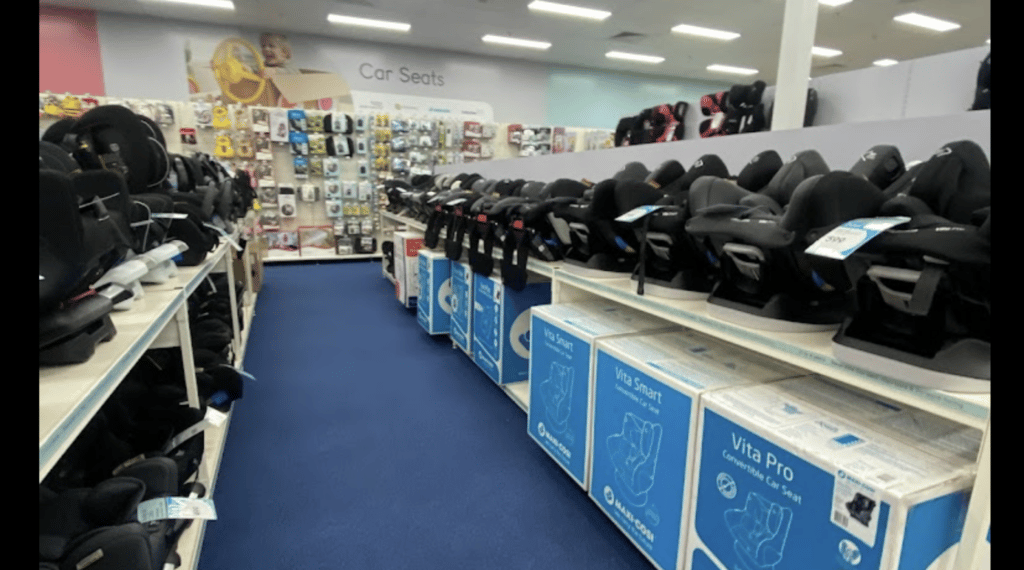

The overall layout offers convenience and most google reviews found the staff to be helpful, supportive and knowledgeable. Baby Bunting has a 3.9-star rating on Glassdoor from 46 reviews and a 3-star rating on Seek based on 58 reviews. The Glassdoor rating is quite high for a retailer and one common piece of feedback was the significant volume of product knowledge required to be learnt. This potentially demonstrates the importance of having knowledgeable staff. I know this should be obvious, but in this case, purchasing baby products can be particularly overwhelming for new parents, so I think the level of support required is much higher than most retailers. A lot of the negative reviews on Seek expressed their frustration at the lack of support from management in terms of training and being overworked. Something to be mindful of when monitoring Baby Bunting’s performance in the context of its customer value proposition.
In terms of adaptation, Baby Bunting has a solid track record of leveraging technology to improve its customer value proposition and achieve operational efficiencies. In its first full year of results for FY 2016, Baby Bunting launched several initiatives including a new responsive website and “click & collect”. In FY2017, Baby Bunting incorporated a Customer Relationship Management (CRM) system and marketing automation platform. A new Baby Bunting gift registry was launched, enabling parents and parents-to-be to create and share gift registries in FY18. During the pandemic, the company acknowledged that the new website that was launched in July 2019 experienced performance and customer experience issues and the decision was made to roll back to the old website in November 2019. In FY 2020, Baby Bunting advised it was making progress in developing online fulfilment hubs with the long-term goal to fulfilling 90% of metro online orders same day.
In the latest FY 2022 results, management noted it has commenced a project to implement Advanced Order Management, with the goal of activating new online fulfilment options, improving order routing and supporting online range expansion. All these initiatives and investments appear to focus on optimising Baby Bunting’s ability to offer the best prices, best convenience and best customer experience for parents and parents-to-be.
When things don’t according to plan, there is a natural instinct to become trigger-happy and find immediate solutions to fix underlying issues. This was on show with boardroom musical chairs at Mothercare. Between 2002 and 2011, Mothercare had the same chief executive, Ben Gordon. However, Gordon was pushed out on the back of poor performance in the UK and after that, the company had three different people at the helm.
One of the CEOs, Simon Calver tried to lift sales by setting up in-store cafes and “mumspace” for activities like yoga. Such quick rash decisions lead to suboptimal results, as Mothercare floated further away from what customers value – price, convenience and support. In stark contrast, Baby Bunting’s CEO Spencer just marked his 10-year milestone this year and CFO Darin Hoekman is approaching nine years by the end of this year. Both have extensive experience in retail, Spencer was a general manager across Australia, New Zealand and the UK for four years and nine months and Hoekman was responsible for the finance function at Godfreys over a similar tenure.
What Happened To Baby Bunting Competitors In Australia?
As you can in the below timeline, many of Baby Bunting’s biggest competitors in Australia collapsed, paving the way for growing gross margins and securing a massive scale advantage within the speciality baby products retail chain market.

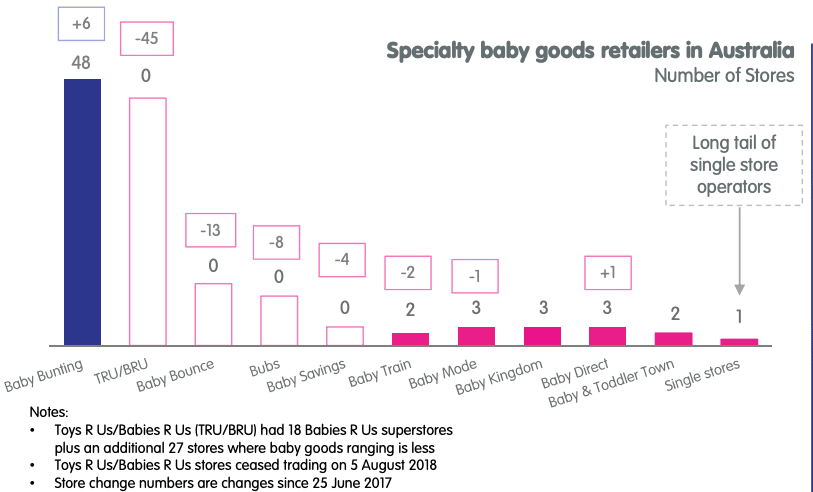
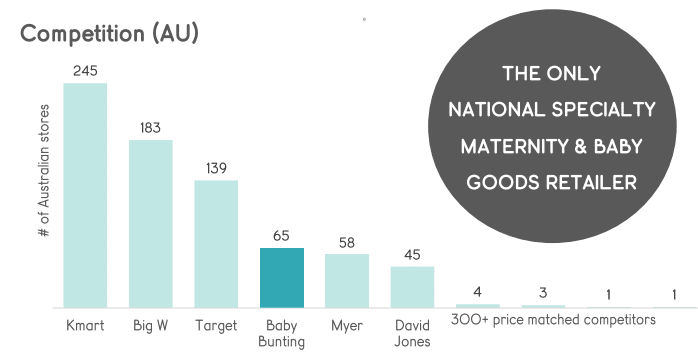
2018 was a year of reckoning as TRU/BRU, Baby Bounce, Bubs and Baby Savings vanished and laid the platform for the ascent of Baby Bunting’s gross margins. This is one of the best examples to illustrate the impact of lower competition on a winner’s gross margins. In the chart below, we can see this in action. When local competitors fall by the wayside, this enables the dominant business to negotiate lower prices with suppliers or raise prices without serious consequence.
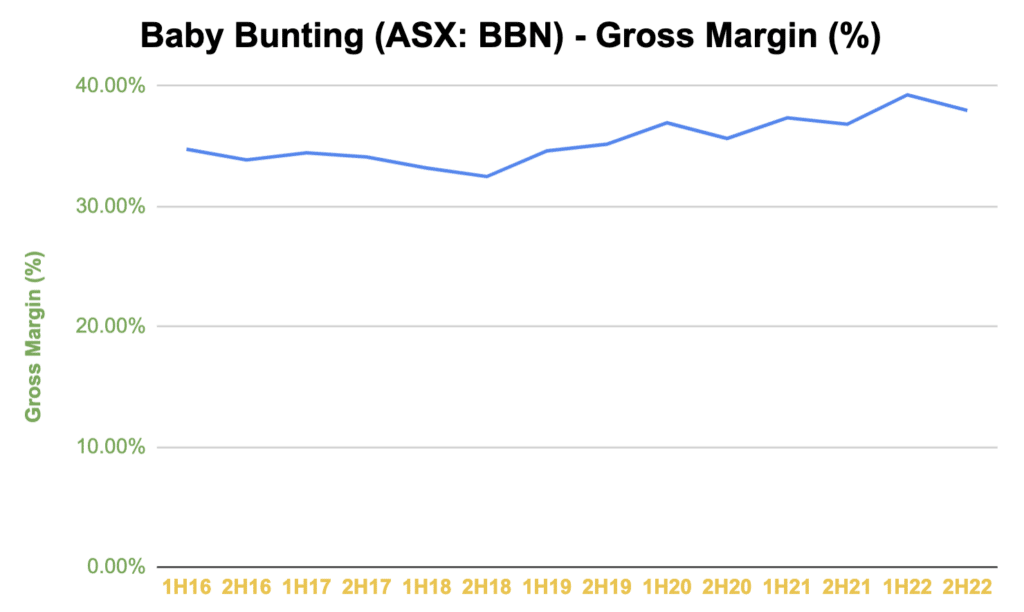
When companies are placed into liquidation, the appointed liquidator is required to submit a report to the Australian Securities & Investments Commission outlining the reasons for failure. A bunch of articles covering the litter of liquidations noted scale and competition as the biggest reasons for failure. As Baby Bunting grew its store count and expanded its reach across Australia, the fight for better prices with suppliers became harder for the smaller competitors. Whilst Baby Bunting is the dominant specialty baby products retailer in Australia, a lot of its product categories like toys and clothes continue to face margin compression due to growing competition from department stores and online juggernauts.
Baby Bunting opened its first store in New Zealand last month but the Baby Bunting competitors in this geography present a much tougher challenge. A lot of these Baby Bunting competitors already have sizeable store networks as seen below.
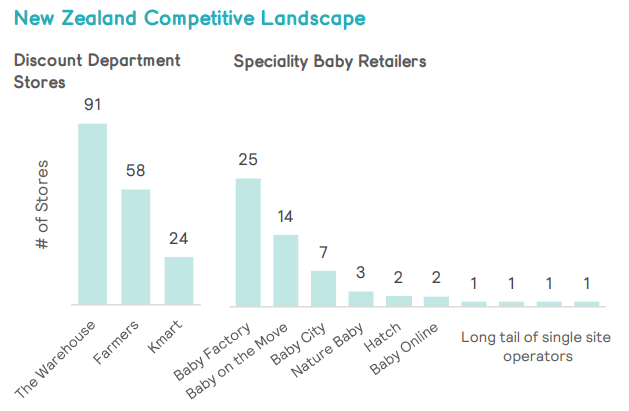
The current growth potential is limited to Baby Bunting reaching its Australian target of 110 plus stores and 10 plus stores in New Zealand. I’d need to take a deeper dive to understand what the total addressable market looks like but in any event, investors shouldn’t apply the same narrative to the New Zealand market opportunity because it seems much more competitive at the outset.
The current PE multiple for Baby Bunting is around 30x and the historical average has been around 36x. This has fallen from an eye-watering high of 80x in February 2021. Overall market sentiment has dropped and there could be more to come for Baby Bunting shares in light of rising interest rates and a decline in the number of births in Australia since 2016. Baby Bunting could very well be thrown into the “perilous retail stocks” basket exposed to worsening macroeconomic factors by the broader market. This is why I’ll be carrying out more research and monitoring this one from the sidelines.
Did you find this article useful? Sign up to receive access to hidden, Free content like this!
Disclosure: the author of this article does not own shares in Baby Bunting (ASX: BBN) and will not trade Baby Bunting shares for 2 days following this article. This article is not intended to form the basis of an investment decision. Any statements that are advice under the law are general advice only. The author has not considered your investment objectives or personal situation. Any advice is authorised by Claude Walker (AR 1297632), Authorised Representative of Equity Story Pty Ltd (ABN 94 127 714 998) (AFSL 343937).
The information contained in this report is not intended as and shall not be understood or construed as personal financial product advice. You should consider whether the advice is suitable for you and your personal circumstances. Before you make any decision about whether to acquire a certain product, you should obtain and read the relevant product disclosure statement. Nothing in this report should be understood as a solicitation or recommendation to buy or sell any financial products. A Rich Life does not warrant or represent that the information, opinions or conclusions contained in this report are accurate, reliable, complete or current. Future results may materially vary from such opinions, forecasts, projections or forward looking statements. You should be aware that any references to past performance does not indicate or guarantee future performance.